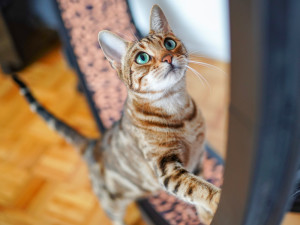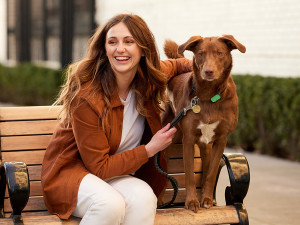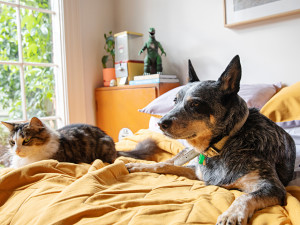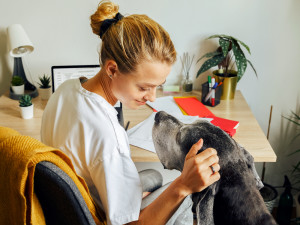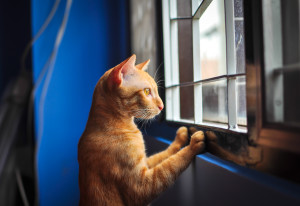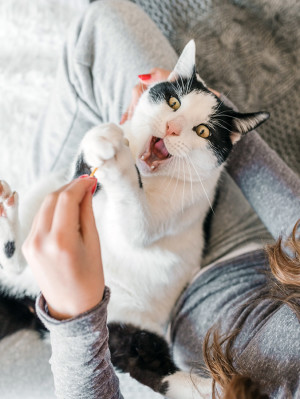5 Ways AI Will Change the Way You Parent Your Pet—Are You Ready?
Advancements in artificial intelligence are changing everything from the way we detect illnesses to how we keep our pets safe.

share article

Your pet wants you to read our newsletter. (Then give them a treat.)
In recent years, there has been a promising shift in how we raise our pets. We’re collectively embracing preventative medicine — and it’s working. One report estimatedopens in a new tab that the average life expectancy of dogs alone increased by 11.4 percent from 2002 to 2016. More people are buying pet insuranceopens in a new tab, some employers are even offering it as a benefit, and the pet-supplement marketopens in a new tab isofficially boomingopens in a new tab. Throw technology in the mix, and the dream of giving our cats and dogs better quality of life is becoming a reality.
This year alone, a slew of innovations driven by artificial intelligence will give us a leg up on everything from illness detection to pet safety, transforming how we parent our pets. “You can buy AI devices that will monitor your [pet], but can also keep track of your dog or your cat poop,” Dr. Lionel Robertopens in a new tab, professor of Information and Robotics at the University of Michigan, tells The Wildest. “They keep track of how much they’re hydrated, activity or lack of activity, even mental health.” Dr. Robert studies the interaction between humans and artificial intelligence in our homes, and to him, the possibilities are becoming intriguingly endless.
“You could even have a robotic pet or companion for your puppy or cat, where that AI basically keeps an eye on it. Maybe it calls back to the parent and says, ‘Hey, is your pet lonely?’” he says. “Imagine a robotic motor animal that can keep track of your pet, keep it active, watch over it, make sure it’s OK. And the pet can [also] have this everyday companion interact with them.”
In the end, your pet gets a buddy, while you get peace of mind. “It gives you the flexibility to feel comfortable to know at any given time I’m not with my pet, my pet isn’t alone or afraid,” Dr. Robert says.
Cloud computing allows anybody to have access to AI because you can store data and process it in real time, he continues. “This is technically feasible, but more importantly, this is economically feasible.” That’s right: The future is here. Behold, some of the coolest innovations pet parents will see in 2024.
We’re much closer to knowing what cat faces are telling us.
Let’s be real: Very few of us are cat whisperers. When it comes to reading their expressions, cats can be total cyphers. But a lucky few people can beta-test an app called Tablyopens in a new tab, which “reads” cats’ facial cues to assess how much pain they may or may not be in. More specifically, this tech, which leans on AI-crunched data, factors-in “ear position, orbital tightening, muzzle tension, whisker positions, and head position” to reach its verdict.
In another recent advancement, researchers studying kitties at a cat cafe in Los Angeles determined that cats, long assumed to be poker-faced, actually have 276 facial expressionsopens in a new tab. (To put that in contextopens in a new tab: Humans only have 44.) This underscores a wholefield of scienceopens in a new tab assiduously devoted to using AI to decode which signifiers indicate your pet’s mood. “As this paper suggests, there is a much greater richness in cat expressions than we appreciate, and what AI is good at is classifying images,” Dr. Daniel Mills, a professor of veterinary behavioral medicine at the University of Lincoln, toldThe Guardianopens in a new tab.
Another studyopens in a new tab, jointly led by a researcher out of University of Haifa in Israel and another out of the University of Veterinary Medicine Hannover in Germany, sought to gauge which cats at a veterinary hospital were feeling pain. They foundopens in a new tab that a cat’s mouth — rather than their ears or eyes — is the most critical indicator when it comes to pain estimation. They’re currently working on an app to help vets and pet parents alike leverage their findings.
Bark translators are going to be a thing.
One of the most interesting dog-tech rivalries is that of Zoolinguaopens in a new tab versusBark GPTopens in a new tab — software endeavoring to become our go-to Dr. Dolittle-esque translator. Both are still-evolving AI-powered apps that aim to decipher what exactly your dog is trying to say each time he or she barks.
Zoolingua is the buzzier of the two, led by Con Slobodchikoff, an animal behaviorist and CEO. He earned recognition thanks to a 2017 The New York Timesopens in a new tab article that rhapsodized over his undeniably cool research into prairie dogs, which boast one of the most advanced animal languages on earth. (They even have their own dialects.)
Slobodchikoff latersaid to CBCopens in a new tab, “[Zoolingua’s] idea is that … the device analyzes the dog’s body language and vocal signals and says, ‘I’m hungry’ or ‘Please let me out,’ ‘I need to pee’ or ‘You’re scaring me,’ or something along those lines.” Ultimately, he hopes to facilitate two-way communication between dogs and humans. “Imagine something as simple as pointing your cell phone at your dog and hearing a translation of what he or she is trying to communicate,” he saysopens in a new tab on the Zoolingua website.
BarkGPT, meanwhile, is currently in beta mode and bills itself as “the world’s first AI bark to speech translator.” Its founder-CEO, Alexandra Setter, is a dog walker–turned–MIT grad, with a background in machine learning. With BarkGPT, you upload the sound of your dog barking, and the app will tell you what they are trying to say. “Developing the machine-learning algorithm for BarkGPT was an incredibly challenging process for our team,” she saidopens in a new tab on their website. “The satisfaction of seeing the impact BarkGPT has on the lives of dogs and their parents makes it all worth it. We remain dedicated to … strengthening the bond between dogs and humans.”
Microchips could be relegated to the past.
The prospect of losing a pet is a pretty upsetting one. Pet parents may forget to microchip their loved one or can’t afford to. Those chips could get damaged. And, while still good to have, old-school ID analog tagsopens in a new tab can easily get lost. With that in mind, a handful of new tech is turning to biometrics — aka using physical characteristics to identify our pets — to supplant all of the above, plus nixing the need to register your pet with your veterinarian.
The pattern of a dog’s nose is purported to be as unique as a human fingerprint, and it’s driving AI apps such as Petnowopens in a new tab (Best of Innovation winner at CES 2022) developed by two engineering PhDs in Korea, to use that nose print to serve as a unique identifier. (Currently, the app analyzes cat’s faces, while it’s working on more robust, feline-specific tech.) “Having attained 99.99 percent matching accuracy for dogs, we are also seeking to progress our technology to cover cats, as well as cattle, in the near future,” the company’s chief operating officer, Meenho Sheen, told GlobalPETSopens in a new tab.
“A lot of these technologies will be able to be leveraged, integrated with your veterinarian, maybe even with animal welfare or the local police where a pet goes missing,” Dr. Robert explains. “They could have all this data.”
Never leave your pet home alone again.
Do we want to spy on our animals when we’re not at home? You bet we do! Well, there are now a full suite of apps aimed at not just observing our pets, but responding to their needs and staying appraised of their wellness. “There’s a lot of opportunity here, making your life that much easier,” Dr. Robert says. “It’s hard to see a downside.”
Facial recognition technology has transformed home security with devices such as the Petvationopens in a new tab, which canopen pet doorsopens in a new tab based on their unique furry faces. The gadget’s sensors are infrared, meaning they work all day and night and don’t require a pet to look directly at its camera. Amazingly, they can detect when your pet wants to leave or enter your house, while also denying entry to other critters such as raccoons and squirrels — not to mention sneaky human beings.
In addition to providing extra home security (by detecting a rogue human), the Furbo 360° Camera opens in a new taband Petcube opens in a new tabare, at heart, pretty effective nannies for both dogs and cats. Through AI, these cams observe your animals all day long, so the software is able to distinguish between normal and irregular behaviors. This means that — in addition to tossing your pet treats and seeing, talking, and playing with them — these technologies will tip you off to more concerning behavior, such as excessive movement, pacing, vomiting, barking, and meowing. For cats, extra-smart litter boxes, such as Petivity, opens in a new tabare also a godsend, monitoring when, how often, and for what reason your kitty uses the litter box, which can indicate a host of health issues.
Other innovations, such as the laser-wielding Felikopens in a new tab, double as pet toys, tracking your cats and dogs throughout your abode and engaging them in play. Meanwhile, the dog-only Companion app opens in a new tabwill actually train your pooch, using AI and positive reinforcement.
Turbocharge your pet’s healthcare.
Maybe the most stunning use of artificial intelligence comes with how it could extend your pet’s lives. Antech Diagnostics (part of Mars Petcare) has been leading the way using AI forearly cancer detectionopens in a new tab in cats and dogs, as well as a predictive tool forchronic feline kidney diseaseopens in a new tab.
"We’re using the power of AI not only to understand how a pet’s genetics and behavior can reveal powerful insights about their overall health but also to help predict disease in pets so veterinarians and owners can better partner to keep pets healthy and happy,” Paulo de Castro, Mars’ CFO of Global Petcare, told opens in a new tab.
Those possibilities are extending to pet parents, enabling us to detect abnormalities before a vet visit, which can sometimes come too late, given hesitations over the expense of veterinary care.PetGenomaopens in a new tab is an at-home DNA test that offers a complete evaluation of your dog’s genetic makeup, which you can use for early disease detection, as well as to design personalized health and nutrition regimes. Meanwhile, theTTcareopens in a new tab app (aCES 2023 Innovation honoreeopens in a new tab) uses artificial intelligence to analyze your dog’s and cat’s health from pictures of their eyes and skin. Your only learning curve will be to get them to sit still.
If you want to go deeper, the VetChip biosensoropens in a new tab will track all your pet’s vitals in real time (heart rate, breathing, temperature, oxygenation), and alert you to any abnormalities, such as fever, stress, and illness. Activity trackers are also getting futuristic: We prefer the Whistle smart collaropens in a new tab, which tracks all dog activity (from licking and scratching to eating, drinking, and sleeping), detects allergies, and even offers poop-scanning.
“If the owner notices that their pet is having some problems, and they bring it in to get looked at…you only know the pet has a problem. There’s no evidence. But if the owner has [video] tape and literature [digital reports], that diagnosis becomes much easier to make,” Dr. Robert says. “So, I think on one hand, we have the benefit of prevention. But then there’s the other issue, which is basically over diagnosis.”
In other words, with this great new power that AI imbues us, comes great responsibility. But we’re pet parents, so we already knew that, right?

Nisha Gopalan
Nisha Gopalan has been a writer/editor for The New York Times, New York magazine, Entertainment Weekly, Variety, The Hollywood Reporter, and NYLON magazines. She currently resides in Los Angeles.
Related articles
![Young woman sitting at desk petting her senior Great Dane]() opens in a new tab
opens in a new tabHow to Speak “Dog”
Lili Chin’s book Doggie Language illustrates how dogs communicate — beyond ear perks and tail wags.
![]()
What Are Dog Communication Buttons? And How to Use Them
Cognitive Science professor Dr. Federico Rossano on how Bunny, TikTok’s “talking” dog, is sparking change in how we communicate with our pets.
![]() opens in a new tab
opens in a new tabHow to Read Your Cat’s Poker Face
A guide to their not-so-secret tells.
![A woman wearing a knit sweater holding a dog close on the floor of her bedroom.]() opens in a new tab
opens in a new tabSeparation Anxiety in Dogs
Train your dog to stay calm when they’re on their own — instead of sad-singing “All By Myself” until you come home.
![orange cat looking out window]() opens in a new tab
opens in a new tabIs Your Cat’s Separation Anxiety Ruining Their Life and Yours?
Why your cat freaks out when you’re away (and how to help).
![a cat making an excited face at a person's hand]() opens in a new tab
opens in a new tabYour Cat Can Make Nearly 300 Unique Facial Expressions, Study Finds
They’re not so mysterious after all.
